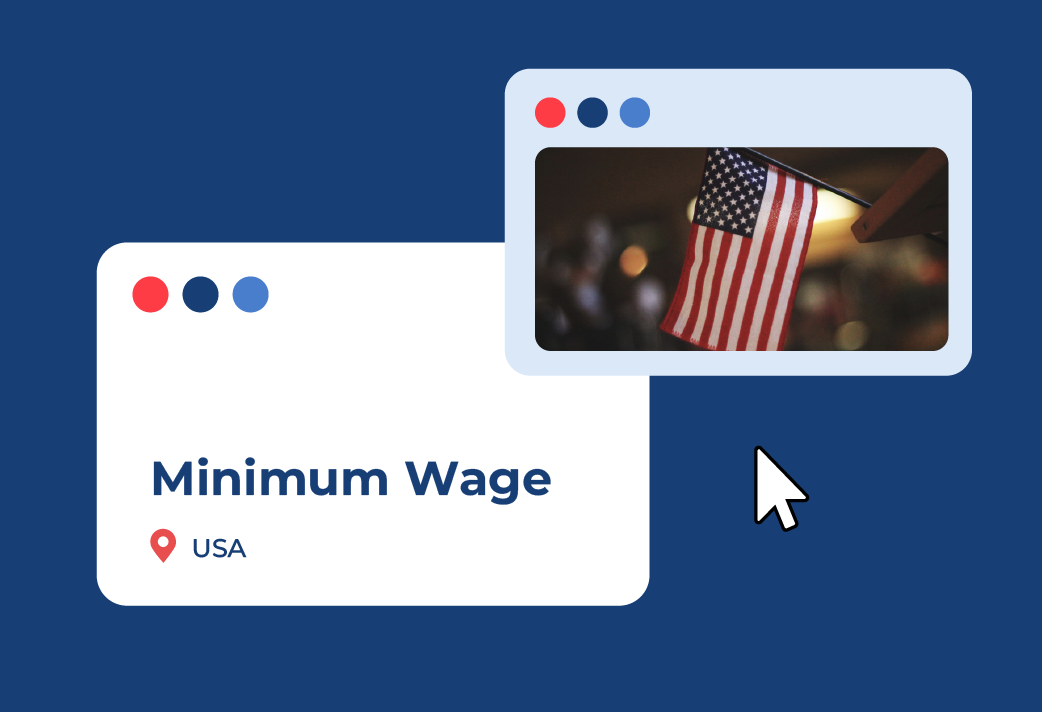International expansion requires a deep understanding of salary standards in new markets. Comprehending the more complex nature of the minimum wage in the USA is essential for effective workforce management, avoiding severe penalties, and ensuring employee satisfaction.
At the beginning of 2024, there are plenty of signs that show a growing interest in changing the rules around the minimum wage in the US. That’s why it’s essential to stay in the loop and ensure your global expansion strategies align with international regulations.
How the Minimum Wage Operates in the USA
The minimum wage in the United States is first determined at the federal level, providing a baseline standard across the entire country.
However, each state, county, and city in the US may then apply its own minimum wage, with some restrictions on the amount. Currently, 30 states have a minimum wage above the federal requirement, and 2 states have minimum wages that are below it.
Global companies operating in the USA must be diligent about adhering to minimum worker benefits regulations, including compliance with the correct minimum wage.
The penalties for a failure to comply may lead to significant problems for a company, both financially and in terms of the way they operate. To navigate these challenges, companies can benefit from the comprehensive support of a payroll services provider such as INS Global, which aids businesses in understanding local best practices and benchmarks.
Determining the Minimum Wage in the USA
Adjustments to the minimum wage in the USA can occur through federal legislation or at the state, county, or city level. There are no defined limits on when a minimum must be adjusted, but amendments are typically made according to market forces or public pressure.
That being said, the federal minimum wage for most workers has not been updated since 2009. The federal government sets the minimum wage in the USA by taking into account factors such as the cost of living, economic conditions, and other relevant considerations.
However, many states and even some cities have set their own, usually higher, minimum wage rates to better reflect the local cost of living or values.
What is the US Minimum Wage in 2024?
US Federal minimum wage: $7.25 per hour
State minimum wages vary according to a variety of factors. Here’s a list of examples of current minimum wages in US states in 2024:
| State | Minimum wage per hour in 2024 (USD) |
| California | 16.00 |
| Texas | 7.25 |
| New York | 15.00 |
| Florida | 12.00 |
| Illinois | 14.00 |
| Pennsylvania | 7.25 |
| Ohio | 10.45 |
| Georgia | 5.15 (7.25 for those still eligible for FLSA) |
| New Jersey | 15.13 |
| North Carolina | 7.25 |
Note: Cities such as Los Angeles ($16.90 per hour) or New York ($16.00) may have minimum wages different from the states they are in.
Exceptions and Adjustments to the Minimum Wage in the USA
The minimum wage landscape in the USA encompasses specific conditions that may exempt workers from the federal minimum wage according to the Fair Labor Standards Act (FLSA).
Industry-Specific Adjustments
Some industries or sectors may negotiate different minimum wage levels through collective bargaining agreements or similar arrangements, yet these agreements must meet or exceed the applicable minimum wage.
The most common exception in this category is that of tip-earning workers. Those who receive tips as part of their job (e.g., restaurant or bar servers) are eligible for the reduced federal minimum wage of $2.13. However, the final amount that a tip-earning worker makes must meet minimum wage per standard hour worked. Tip-earning minimum wage may also differ according to the state.
Age
Students or workers under 20 in the first 3 months of employment are also exempt from being eligible for the standard minimum wage in the USA, being only eligible for the lower $4.25 minimum.
Disabilities
Workers with disabilities that impair their abilities may be paid according to their output proportional to a non-disabled worker, meaning that they are allowed to be paid below the federal minimum wage. However, companies must first apply for a certificate of exemption in order to do this.
The Minimum Wage in the USA and Special Work Hours
The USA has specific regulations governing special work hours:
Overtime Pay
Overtime must be compensated at a rate of 1.5X the standard salary for non-exempt employees (e.g., those who meet monthly or annual salary minimums, seasonal workers, commission-based salespeople, etc.) working beyond 40 hours per week.
Rest Days and Public Holidays
There are no federally mandated requirements for extra or premium pay on weekends or holidays in the US.
However, certain state or local regulations may dictate premium pay for these situations.
Tools for Determining Minimum Salaries in the USA
Local Labor Authorities
While the federal government sets the minimum wage in the USA, local government authorities may play a role in enforcement and may have additional regulations, especially in states with higher minimum wages.
As a result, it’s more important than usual to check with state and local authorities before determining a worker’s local minimum wage in order to be sure that such actions meet legal standards at each level.
Ensuring Compliance in the USA with INS Global
Non-compliance with minimum wage in the USA can lead to severe consequences. INS Global offers compliance and global expansion services to help businesses navigate these challenges, providing support during critical periods of transition. With expertise in HR operations and employment law compliance worldwide, INS Global facilitates a smooth entry into the US market.
Whether it’s recruiting, payroll, compliance, or HR streamlining services, our local Employer of Record (EOR) in the USA offers tailored solutions to meet your specific business needs.
For more information on ensuring a seamless journey through the intricacies of the US market, contact our expert global expansion advisors today.


SHARE